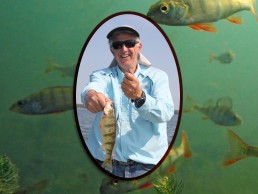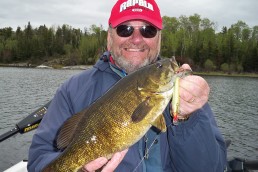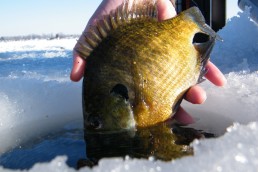Artificials for Panfish
SHARE THIS POST
Panfish, much like bass and walleyes follow their own calendar. First is ice out, then the pre-spawn, followed by the spawn. Locations and techniques change as the seasons change. Ice-out is normally a three- or four-week period, followed by the pre-spawn which might last two to four weeks, depending on the weather conditions. The spawn might last one to three weeks, once again, weather dependent.
Ice-out crappies, gills and perch are looking for food. The shallowest waters will be the warmest and hold the best forage. A warming sun is a plus, but more important is a few days of stable weather. Second, locating the fish, which is really easier than one might think. Think warm water, shallow bays, canals, manmade channels and areas where a creek or drainage ditch might be located. Current flowing in brings nutrients. Think muck, logs, debris and muskrats. If a muskrat leaves there, the crappies most likely will be there. Look for dirty water or water with some color to it.
Find the warmth, find the fish
The warmest water is often on the northeast side of the lake and the minnows will be there. These locations should not be confused with the actual spawning areas. Rarely are the two one in the same. Warm water is also a surface thing. You can bet that most of the fish will be found in the top 1 to 5 feet of the water column.
Techniques vary, super-slow trolling with long rods is one option. Slip floats or casting floats is the second option. If fishing a canal or a manmade channel, then the float combo is the best. If fishing a protected cove or shallow bay, a super-slow troll is excellent.
There are times that we troll to find the fish and then use our spot lock on the trolling motor or anchor and fish with floats. Receive the wrong wind and the warm water might blow out of the shallows. The fish rarely will leave the general area. Instead, they can be found on the first drop-off or suspended over the nearest deep-water basin.
Fish on the drop-off or highly suspended fish over a deep-water basin are best picked off with some type of float system. Most crappie anglers never thought of using a float with the jig but it works great. It keeps your lure at the right depth and you can stop and go and drive a nice, platter-size crappie nuts.
Go slow, get bit
Early season fish want a very slow-moving bait, very much like ice fishing. We use a lot of the Southern Pro tube jigs. They will pulsate at the slowest speeds and will dance by just twitching your rod tip. Most cases, we tip a tube jig with a small minnow or with a Berkley crappie Nibbled. Spikes and wax worms also worm on tube jigs.
Small hair jigs, Lindy Quiver jigs, the Pinky Jigs and the Gypsy Jigs are very good cold-water jigs. Feather, marabou and hair jigs have a natural buoyance to them and they flutter with the breeze. We tip these jigs with a smashed wax worm.
Ice-out gills will hammer small flies and gnats. In the shallow waters, a casting float is hard to beat. A casting float has an eye ring on both ends. You tie your main line to the top eyelet. Then tie a 4-pound fluorocarbon leader that is a foot shorter than the length of your rod. Tie on your fly or gnat. Some days a single spike is beneficial.
Trollin’ ‘gills
Many times at sunset you will see small rings on the surface over deep water. This is hammer time on nice bluegills!
At ice out, we troll six rods off of the front of our boats. I use the rod holders from Driftmaster. They are completely adjustable and a snap to use. Trolling with the wind at your back often means running two drift socks. Under a fairly stiff breeze, we can still maintain a .3 mph speed which is about perfect at this time of the year.
While we start with tubes of hair jigs, we will switch over to an Aberdeen hook. You want a hook that can go through the lips of a minnow and still stick the crappie. When using a jig and minnow, make sure and get a jig with a large hook and a long shank. The Charlie Brewer jigheads are perfect for this, as are the tube heads from Southern Pro.
We use 1.5-inch tubes the most because our crappies tend to run 2 to 4 inches smaller. A minnow is a must, even when using a tube during the pre-spawn, ice-out specks.
Are you enjoying this post?
You can be among the first to get the latest info on where to go, what to use and how to use it!
Tying rigs for tube jigs
When using tube jigs, we tie our own rigs. I tie a loop knot and on each loop I have a Speed Snap from Arnold Tackle. This little speed snap allows us to change from a jig to a hook or to a different style of jighead without retying our rigs. We then use a bell sinker or a couple of split shots from Bullet Weights. The beauty of these rigs is that you can use them all summer for bluegills, crappies and perch with minimal changes.
Troll as slow as possible and keep your baits vertical. Often this is .3 mph. Follow the shoreline, swing over to the drop-off, duck in tight to a dock or brush in the water. No luck? Glide out over the deeper water while maintaining your baits at the same depth. Two to eight feet down is about the perfect depth range. In real shallow water, your top bait might be down only a few inches. This system works great in any depth of water that the crappies are using.
When you troll in 1 to 4 feet of water, you need a long rod. We use 12 and 14-foot B & M rods. With the rod holder system, you can sneak right up on a crappie. If you switch over to gnats and flies and utilize a start-and-stop glide method, gills will gobble up your offerings.
Fish in bloom
When the lilacs start to bloom, crappies are on the beds. Within two weeks, the bluegills will move on their beds. What a great time for the angler and their families and friends. Crappies and perch like weeds and reeds. Gills like a mixture of weeds, pads and sand and pea gravel. Fish will move in and out from the nearest breakline all day.
The “do-nothing” technique was created by Charlie Brewer Sr. Some anglers call it the father of finesse fishing. I call it the simplest technique to learn and master and a technique that works all season long.
A special jighead was designed that is flat and glides or slides through the water. Small, plastic baits were used—often 4 inches or shorter. Crappie anglers were using and still use 1.5-inch tails.
Sometimes simple is best
The basic retrieve was to cast out and slowly retrieve. Nothing extra added. This simple retrieve works on bass, gills, crappies and walleyes. This was way before swimbaits and even before Mr. Twister hit the market. The Charlie Brewer tail shimmers much like a minnow. The Mr. Twister has a wider wiggle and is best on aggressive fish or warmer waters.
During the spawn, many of your bedding fish will lash out at anything that comes within a foot of their beds. As they complete or just prior to the fish spawning, they will cruise the weed tops. Remember that not all fish are actually on the beds at the same time. Do not forget a float-and-jig combination. The float controls the depth and you can work your rod tip to make your lure dance right on top of a fish.
Check the cover
Bluegills do like some type of overhead cover. Some of our best spots have tree limbs hanging over the potential bedding areas. Bluegill beds are easy to spot, especially with a good pair of polarized sunglasses.
Gills build nests in colonies that often overlap another gill. They look like a bunch of saucers. During the height of the spawning season, a good spawning ground will have a musty smell much like a musk scent. The surface will also have a scum layer across it.
The bigger gills spawn in depths where it can be harder to see their beds. Thus, if you find a colony of gills in 3 to 4 feet of water, back off and try 5 or 6 feet of water. Just remember that it is the male that protects the nest. Do not take all of the males off of one colony. Save a few and find another colony.
Once you try a combination of plastics and meat, you will enjoy more fish and often larger fish. Bonus walleyes will be caught on the new weeds as well. Slow troll or work fish with a float. They both work and you have an 8-week window of fun.
MWO
SHARE THIS POST
Did you enjoy this post?
You can be among the first to get the latest info on where to go, what to use and how to use it!
Jack Payne
Jack Payne is an accomplished angler and hunter who enjoys teaching others as much as learning from others. Seminar speaker, outdoor photography enthusiast, hunter safety instructor and volunteer at many events for both kids and adults as an instructor.



